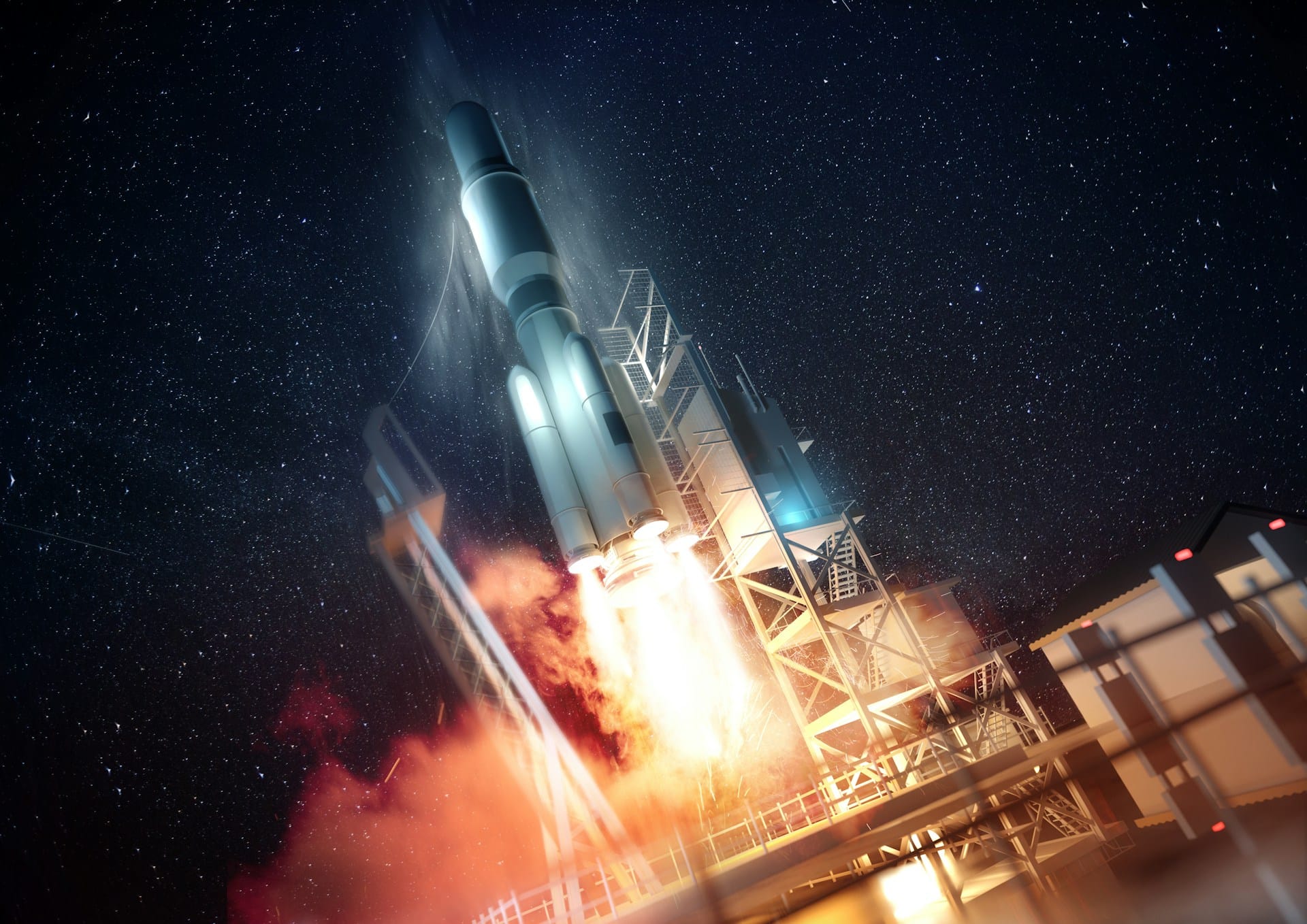Now Reading: 第一季:星际启航 | Galactic Genesis|第1集:跨越时空:探索未来的无限可能
-
01
第一季:星际启航 | Galactic Genesis|第1集:跨越时空:探索未来的无限可能
第一季:星际启航 | Galactic Genesis|第1集:跨越时空:探索未来的无限可能

Crossing Time and Space: Unveiling the Infinite Possibilities of the Future
在浩瀚无垠的宇宙中,人类的足迹仍然局限于我们熟悉的蓝色星球——地球。无论是站在城市的高楼上,还是远眺星空,我们都能感受到一种深刻的召唤:未来,似乎正悄然向我们展开。技术的飞速发展正在引领我们走向一个全新的时代,一个跨越时空界限的时代。也许,在不久的将来,我们不仅能遥望星辰,还能亲身踏上属于我们的星际旅程。
想象一下:你置身于一个未来城市的最高塔楼,从这里,你能看到地球的曲线逐渐消失,取而代之的是深邃的宇宙。或许,你正准备登上航天飞船,开启一次前往未知星球的旅程。而这一切,不再是科幻电影中的幻想,而是基于当前技术进步的一种可能。今天,我们所追寻的每一次技术突破,正是推动我们跨越地球、跨越星际的桥梁。
In the vastness of the cosmos, humanity’s footprint remains confined to the familiar blue planet — Earth. Whether standing atop the tallest buildings in the city or gazing at the starlit sky, we all feel a profound call: the future seems to be quietly unfolding before us. The rapid development of technology is guiding us into a new era — one that transcends the boundaries of time and space. Perhaps, in the not-so-distant future, we won’t only be able to gaze at the stars, but will also be able to set foot on our very own interstellar journey.
Imagine this: you stand atop the highest tower of a futuristic city, and from here, you see the curvature of the Earth slowly disappear, replaced by the endless expanse of the cosmos. Perhaps you’re preparing to board a spacecraft, embarking on a journey to an unexplored planet. And all of this is no longer the fantasy of a science fiction movie, but a very real possibility driven by the advances in today’s technology. Each breakthrough we pursue today is a bridge leading us from Earth to the stars, from the known to the unknown.
跨越时空的力量:
如今,人工智能、虚拟现实、区块链等前沿技术正以前所未有的速度发展着。它们不仅改变了我们的日常生活,更在悄然塑造着一个全新的全球社会。每一项突破,都意味着人类向星际文明的跨越迈出了新的一步。这些技术带来的变革,远不止于地球——它们将如何在未来星际社会中发挥作用?这些技术如何改变我们与宇宙的关系?今天,我们将从一个跨越时空的视角,探索这些技术如何影响人类未来,如何让我们跨越已知与未知的边界,迈向星际时代。
The Power of Crossing Time and Space:
Today, technologies like artificial intelligence, virtual reality, and blockchain are developing at an unprecedented pace. These advancements are not only changing the way we live but are quietly shaping a new global society. Each breakthrough signifies another step toward interstellar civilization. How will these technologies function in future interstellar societies? How will they reshape our relationship with the cosmos? Today, we will take a timeless, intergalactic perspective to explore how these technologies are influencing humanity’s future and how they will help us cross the boundaries between the known and the unknown, leading us into the interstellar age.
从现在,到未来,从地球,到宇宙:
让我们把视线从熟悉的地球扩展至广阔无垠的宇宙深处。想象着,未来的全球社会将不再受限于国界与地域。随着技术的进步,我们不仅能连接地球上的每一角落,更能连接星际间的文明。这不仅是科技的胜利,也是人类文明的一次大飞跃——一个由数字、信息、智能和虚拟世界编织而成的星际时代。
今天,我们站在变革的起点,而未来,正如星辰般璀璨可期。让我们一同揭开这场跨越时空、探索未知的旅程。
From Now, to the Future; From Earth, to the Cosmos:
Let us expand our gaze from the familiar Earth to the infinite depths of space. Imagine a future where the global society is no longer confined by borders or geography. As technology progresses, we will not only connect every corner of the Earth but also the civilizations scattered across the stars. This is not only the victory of technology, but also a great leap for human civilization — an interstellar age woven together by data, information, intelligence, and virtual worlds.
Today, we stand at the precipice of change, and the future, like the stars themselves, is dazzling with endless possibilities. Let us begin this journey of crossing time and space, exploring the unknown together.
铺就通向星际的道路:当今科技如何塑造我们的未来
当我们站在这个新时代的门槛上,首先需要了解的是那些不仅仅在改变我们的世界,而是积极引导我们迈向宇宙的突破性科技。曾经,太空探索似乎是政府和宇航员的专属领域,而今天的技术进步却为全人类开启了通往星际的梦想。在这一部分,我们将探索那些使星际梦想成为现实的科技:人工智能、虚拟现实和区块链。
Paving the Path to the Stars: How Today’s Technologies Are Shaping Our Future
As we stand at the threshold of this new era, it’s essential to first understand the groundbreaking technologies that are not just reshaping our world, but are actively guiding us toward the cosmos. While space exploration once seemed like an exclusive domain for governments and astronauts, today’s technological advancements have opened the door for all of humanity to dream of the stars. In this section, we will explore the technologies that are making interstellar possibilities a reality: Artificial Intelligence, Virtual Reality, and Blockchain.
人工智能:机器背后的智慧
想象一个未来,人类的智慧与机器相结合,不仅思考,还能学习和适应。人工智能(AI)已经开始改变各行各业,从医疗到交通,它迅速成为太空探索的基础工具。今天,AI帮助我们处理海量的数据,使我们能够分析来自遥远星球和星系的信息。但AI的真正力量在于它的进化能力。
在太空任务中,AI被用于管理航天器系统、预测并解决复杂问题,甚至协助宇航员在太空中的工作。随着AI技术的不断发展,它可能成为自主航天器的核心动力,使我们能够在没有人类持续干预的情况下探索遥远的星系。未来,AI不仅将帮助我们导航星际,还可能协助我们在远离地球的星球上建立智能文明,管理从农业到治理的一切事务,且人类的参与将更加精简。
Artificial Intelligence: The Mind Behind the Machine
Imagine a future where human intelligence is enhanced by machines that not only think but learn and adapt. Artificial Intelligence (AI) is already transforming industries, from healthcare to transportation, and is quickly becoming a fundamental tool for space exploration. Today, AI helps us process vast amounts of data, making it possible to analyze information from distant planets and stars. But the true power of AI lies in its ability to evolve.
In space missions, AI is being used to manage spacecraft systems, predict and solve complex problems, and even assist astronauts in space. As AI continues to advance, it could become the guiding force behind autonomous spacecraft, allowing us to explore far-flung galaxies without the constant need for human intervention. One day, AI may not only help us navigate the stars but could also assist in the creation of intelligent civilizations on distant planets, managing everything from agriculture to governance, all with minimal human oversight.
虚拟现实:在地球上体验宇宙
太空旅行曾是许多人无法触及的梦想,但通过虚拟现实(VR)技术,宇宙不再是遥不可及的幻想,而是我们可以亲身体验的现实。VR技术让我们能够模拟太空旅程,让人们体验漂浮在零重力状态中、在火星表面行走,或穿越土星的光环的感觉。
然而,虚拟现实的潜力远不止于个人体验。对于宇航员来说,VR提供了沉浸式的训练模拟,帮助他们为太空旅行的严酷现实做好准备。它能够重现微重力环境,帮助宇航员练习应急操作,测试他们在太空中面对孤独时的心理韧性。随着VR技术的不断发展,我们可以期待更加真实的模拟,可能彻底改变我们培训宇航员的方式,也让任何人都能“访问”星空,模糊虚拟与现实的界限。
Virtual Reality: Experiencing the Cosmos from Earth
Space travel has long been an unattainable dream for many, but with Virtual Reality (VR), the cosmos is no longer just a distant dream — it’s an experience that can be had from the comfort of our homes. VR technology allows us to simulate space journeys, enabling people to experience what it’s like to float in zero gravity, walk on the surface of Mars, or journey through the rings of Saturn.
But VR’s potential reaches far beyond personal experiences. For astronauts, VR offers immersive training simulations, preparing them for the harsh realities of space travel. It can recreate the microgravity environment, help them practice emergency protocols, and test their psychological resilience in the vast isolation of space. As VR technology continues to evolve, we can expect even more realistic simulations, potentially revolutionizing the way we train space explorers and allowing anyone to “visit” the stars, blurring the lines between the virtual and the real.
区块链:星际经济的新纪元
在跨星际贸易和资源共享的世界里,我们如何确保经济的安全性、去中心化和透明性?区块链技术——数字货币背后的核心技术——提供了一个独特的解决方案。尽管区块链最著名的应用是数字货币,但它在太空探索中的潜力更为深远。区块链可以为跨星际的商品和服务交换提供一个安全、去中心化的管理方式。
想象一个未来,从小行星或月球开采的资源将在太空中流通,交易会通过不可篡改的区块链账本进行管理。这个技术还可以确保太空任务中的数据在地球上的各大机构间安全共享,创造一个透明且无法篡改的探索和发现记录。通过这种方式,区块链可能会成为新型星际经济的支柱,将行星、卫星甚至遥远的太空站连接在一个无缝的去中心化网络中。
Blockchain: A New Era of Space Economy
In the world of interplanetary trade and resources, how do we ensure that the economy remains secure, decentralized, and transparent? Blockchain technology — the underlying force behind cryptocurrencies — offers a unique solution. While its most famous application is in digital currencies, its potential in space exploration is even more profound. Blockchain can provide a secure, decentralized method for managing the exchange of goods and services across the vast distances of space.
Imagine a future where resources mined from asteroids or moons are traded across space, and transactions are managed on an immutable, blockchain-based ledger. This technology could also ensure that data from space missions is securely shared across Earth-based institutions, creating a transparent and tamper-proof record of exploration and discovery. In this way, blockchain could form the backbone of a new intergalactic economy, linking planets, moons, and even distant space stations in a seamless, decentralized network.
技术的融合:未来的曙光
当我们将这些技术结合在一起时,未来的可能性几乎是无限的。人工智能、虚拟现实和区块链并非孤立发展的,它们正在融合,创造一个太空探索成为日常生活一部分的未来。设想一个场景,人工智能管理一次太空任务,虚拟现实让你从家中就能亲身体验,而区块链则确保每一次交易和资源交换的安全。这些技术不仅是工具,它们正在创造一种全新的星际互动范式,让地球与宇宙之间的边界逐渐消失。
随着我们展望未来,这些技术正为人类进入星际的旅程铺设道路。它们是我们探索和定居宇宙的第一步。今天,我们不再仅仅仰望星辰,我们正在建设通向它们的桥梁。
在接下来的部分,我们将深入探讨这些技术如何塑造星际社会的未来,为我们在星际世界中建立新的文明提供基础。
The Convergence of Technologies: A Glimpse of the Future
When we combine these technologies, the possibilities are limitless. AI, VR, and blockchain are not isolated developments; they are converging to create a future where space exploration becomes a part of everyday life. Imagine a scenario where AI manages a space mission while VR allows you to experience it from your living room, and blockchain ensures the security of every transaction and resource exchange along the way. These technologies are not just tools; they are creating a new paradigm of interstellar interaction, where the boundaries between Earth and the cosmos are slowly but surely disappearing.
As we look ahead, these technologies are preparing us for the inevitable expansion of humanity into the stars. They are the first steps in our journey to explore and inhabit the cosmos. Today, we are no longer just looking up at the stars in wonder — we are actively building the tools to reach them.
In the next section, we will explore how these technologies are shaping the future of interstellar society, laying the foundation for the civilization we will one day build among the stars.
星辰之间的社会架构:从地球到星际文明的演变
当我们踏上未来的星际征程,除了探索未知的星球,建立一个全新的社会体系也是我们的伟大使命之一。如今,随着科技的不断进步,我们不再仅仅满足于把科技应用于地球上。人类文明的未来将不仅局限于地球,而是将在星际之间蔓延。而为了实现这一梦想,跨越地球与星际的障碍,构建一个全新的星际社会架构,是我们必须解决的课题。在这一部分,我们将探讨如何从当前的全球社会发展到星际社会,科技如何帮助我们克服跨星际的挑战,以及我们如何为未来的星际文明打下基础。
Building Society Among the Stars: From Earth to Interstellar Civilization
As we embark on our journey into the future of interstellar exploration, we are tasked not only with discovering new planets but also with establishing an entirely new societal framework. Today, as technology continues to advance, we no longer see our civilization as limited to Earth alone. Human civilization’s future will expand beyond our home planet, spreading across the cosmos. And to realize this dream, overcoming the barriers between Earth and the stars, and building a new interstellar society, is one of our greatest challenges. In this section, we will explore how we move from our current global society to an interstellar one, how technology helps us tackle the challenges of interstellar expansion, and how we can lay the groundwork for future interstellar civilizations.
从地球到星际社会:跨越时空的文明之路
从古至今,人类的文明总是围绕地球上的国家、文化和社会体系展开。随着科技的不断发展,尤其是信息技术和全球化的推进,我们已逐步进入一个相互连接的全球社会——一个无国界、无地域限制的“全球村”。然而,随着我们向星际社会的迈进,地球文明如何逐步向星际文明过渡,将成为我们面临的最大挑战之一。
星际社会将不再依赖于传统的国界和地理位置,它将成为一个更为复杂和多元化的系统。未来的星际社会可能将由来自不同星球、不同文明的群体组成。与地球上的传统国家形式不同,星际社会可能以星际联邦、星际联盟或完全去中心化的形式存在。各星球或星际站点的居民将在相互独立的生态系统中生活,但他们的交互和合作将通过先进的科技系统紧密相连。
From Earth to Interstellar Society: The Pathway of Civilization Across Time and Space
Throughout history, human civilization has been built upon nations, cultures, and social systems here on Earth. As technology has advanced, especially with the rise of information technologies and globalization, we have moved into a more interconnected global society—a “global village” that transcends borders. However, as we move toward an interstellar future, the transition from Earth-based civilization to a thriving interstellar society will be one of the most profound challenges we face.
An interstellar society will no longer be defined by traditional borders and geography. It will be a far more complex and diverse system. The future of our interstellar society may consist of groups from different planets, moons, or even independent space stations. Unlike Earth’s traditional nations, an interstellar society may take the form of an interstellar federation, alliance, or even a completely decentralized system. Each planet or station will have its own ecosystem and governance, but they will remain interconnected through advanced technological systems.
跨星际的挑战与解决方案
建立一个星际文明并非没有挑战。首先是时间和空间的巨大障碍。跨越星际的巨大距离,意味着我们必须解决通信延迟、资源流通以及生命支持系统等多个问题。例如,当一个星际站点与地球之间的通信信号需要数年才能往返时,如何确保信息的高效传递?如何解决资源的分配和交换,使得各星际社会能够自给自足,同时又能实现合作与共享?
这些挑战正是当今科技所要解决的关键问题。通过量子通信技术,我们可以解决星际通信中的延迟问题,实时传输关键信息;通过人工智能和区块链技术,资源的分配和管理可以实现去中心化和智能化,提高效率和透明度。正是这些前沿技术的结合,使得跨越星际的文明愿景从幻想走向现实。
The Challenges of Interstellar Expansion and Solutions
Building an interstellar civilization is no easy task. First, there are the vast distances and time barriers we must overcome. Traveling between stars and establishing communication across such great distances means that we need to solve problems related to communication delays, resource distribution, and life support systems. For instance, when communication signals between Earth and an interplanetary station take years to travel back and forth, how can we ensure that vital information is transmitted effectively? How can we ensure the smooth flow of resources and trade across such immense distances?
These challenges are at the heart of the problems that today’s technologies are striving to solve. Quantum communication technology, for example, could solve issues related to communication delays, allowing real-time transmission of critical information across the stars. Meanwhile, artificial intelligence (AI) and blockchain technologies can help manage and distribute resources efficiently, ensuring fairness and transparency in interplanetary trade and cooperation. By combining these technologies, we can make the vision of interstellar civilization a practical reality.
星际社会的组织架构:新的秩序与治理方式
随着星际社会的逐步形成,我们需要考虑新的社会组织架构。在未来的星际社会中,传统的政府形式可能不再适用。考虑到星际之间的巨大距离和各自独立的生态环境,如何确保每个星际站点或星球的自治权和治理体系?这就要求我们构建一种全新的治理模式。
一种可能的模式是“星际联邦”。各星球或星际站点可以作为独立的自治单位,享有相对独立的政治、经济和社会制度,同时又通过一个统一的联邦框架协调合作。这样的联邦结构不仅能保持各单位的独立性,也能确保整个星际社会的稳定性与发展。
另外,随着人工智能的普及,智能系统可能会成为星际社会的核心治理机制。在这种模式下,人工智能将负责各类决策的执行,从资源管理到社会福利,从环境保护到安全保障,AI将以最优化的方式帮助星际社会解决各类问题。通过这样的系统,星际社会将能够实现高效、透明且公平的治理。
The Organization of Interstellar Society: A New Order of Governance
As we look to the formation of interstellar societies, we must also think about the new governance models that will be necessary to manage these vast, far-flung populations. In a future interstellar society, traditional forms of government may no longer be applicable. Given the immense distances and different environmental conditions of distant planets, how do we ensure the autonomy and governance of each space station or planet? How do we create a governance structure that coordinates the various parts of the interstellar society?
One possible model is the creation of an “interstellar federation.” Planets, moons, and space stations could serve as independent, self-governing units with their own political, economic, and social systems, while working within a larger, unified framework to coordinate efforts across space. This model would allow each unit to maintain its own identity and autonomy while ensuring the stability and progress of the entire interstellar society.
Additionally, as artificial intelligence becomes more integrated into our systems, it could become the cornerstone of governance in interstellar societies. AI could be responsible for executing decisions across various domains, from resource management to social welfare, environmental protection to security. In this system, AI would function as the ultimate tool for ensuring efficiency and fairness, managing the complex needs of a multi-planetary society. By leveraging AI, interstellar societies could achieve a high degree of coordination and management, helping to avoid the pitfalls of bureaucracy and human error.
星际文明的道德与伦理考量
随着我们逐步迈向星际时代,伦理和道德问题也将成为不可忽视的话题。从对外星生命的伦理对待,到跨星际资源开采的道德考量,如何在星际文明中建立一种既符合人类价值观,又能够适应宇宙广袤背景的道德体系,将是未来社会亟待解决的关键问题。
在星际社会中,我们或许将遇到不同于地球的生命形态与环境。如何确保人类文明的扩展不会对这些新生命体或星球生态造成负面影响?如何在追求星际资源的同时,避免贪婪和破坏性开采?这些问题将需要通过深入的伦理讨论与科技解决方案相结合,确保我们的星际文明不仅能在技术上取得突破,更能在道德与人性上保持高度的自觉与尊重。
Ethical and Moral Considerations in Interstellar Civilization
As we move toward the interstellar era, ethical and moral questions will become increasingly critical. From how we treat potential extraterrestrial life to the ethical considerations of resource extraction from other planets, how we establish a moral framework for interstellar society will be vital for ensuring that humanity’s expansion into the stars is beneficial for all, including the environment and potential life forms beyond Earth.
In interstellar society, we may encounter entirely new life forms, ecosystems, and environments. How can we ensure that humanity’s expansion does not harm these alien life forms or ecosystems? How can we responsibly manage the extraction of resources from other planets while avoiding the reckless exploitation that has marred Earth’s history? These questions will need to be addressed through a careful and thoughtful approach that balances progress with respect for the unknown.
星际社会的未来蓝图
星际文明的构建,是科技、人类智慧与道德自觉的完美结合。随着人工智能、虚拟现实、区块链等技术不断发展,我们将逐步迈向一个全新的星际社会。在这个社会中,地球不再是我们唯一的家园,而是星际文明的起点。无论是跨星际的资源共享,还是星际站点的治理与合作,未来的星际社会将是一个多元、去中心化、智能化的全球生态。
随着这些技术的成熟和社会结构的演变,我们的目标将不再仅仅是探索星辰,而是要在这些星辰之间创造出属于人类的文明。在未来的星际世界中,我们将站在新的高度,迈向无限的宇宙边际,去探索那些我们未曾触及的未知。
The Blueprint for Interstellar Society
The creation of an interstellar civilization is a perfect marriage of technology, human wisdom, and moral responsibility. As artificial intelligence, virtual reality, blockchain, and other technologies continue to evolve, we are gradually moving toward a new type of society—one that extends far beyond Earth. In this future interstellar society, Earth will no longer be our only home but will be the starting point for a much larger, intergalactic civilization. Whether it’s the sharing of interstellar resources or the governance of space stations, the interstellar society will be a diverse, decentralized, and highly intelligent ecosystem.
As these technologies mature and our societal frameworks evolve, our goals will no longer be limited to exploring the stars but will extend to creating and maintaining civilizations among them. In the future interstellar world, we will stand at new heights, pushing the boundaries of our known universe and venturing into the infinite frontiers that await us.
人类与机器的共生:科技进步如何塑造我们的未来
随着科技的飞速发展,科技对社会的影响越来越深刻,不仅改变了我们的生活方式,还逐步塑造了人类的未来。这些变化的核心不仅体现在我们日常使用的工具和设备上,更深刻地影响着我们的身体、思想、行为和社会结构。科技不再只是外在的工具,它逐步融入到人类的生理和心理层面,改变着我们如何定义“人类”本身。在这一部分,我们将探索科技进步如何重新定义人类的形态与生活方式,以及随之而来的伦理与道德挑战。
Coexistence of Humans and Machines: How Technological Advancements Are Shaping Our Future
As technology advances at an unprecedented rate, its impact on society becomes deeper and more profound. Technology is not only changing the way we live but is gradually reshaping the future of humanity. These changes are not limited to the tools and devices we use daily but are influencing our bodies, minds, behaviors, and social structures. Technology is no longer just an external tool; it is gradually integrating into human physiology and psychology, altering how we define “humanity” itself. In this section, we will explore how technological advancements are redefining human form and lifestyle, as well as the ethical and moral challenges that come with it.
人类的未来形态:从生物到超人类
随着生物技术、基因编辑和人工智能等领域的突破,人类正在迈向一个可能出现的“超人类”时代。科技正使我们具备前所未有的能力——不仅可以治疗疾病,还可以增强我们的身体和智能。这些技术不仅能延长人类寿命,甚至能让我们改变基因、增强智力、强化感官,从而提升我们的身体和精神能力。
例如,基因编辑技术,如CRISPR-Cas9,已经使我们能够修改人类的基因,治疗遗传性疾病。未来,这项技术可能被用于增强人类的生理特征,甚至赋予人类一些常人无法拥有的能力。与此同时,人工智能的进步使得我们有可能通过大脑-机接口等技术将机器与大脑直接连接,从而增强我们的认知能力,甚至让我们具备更强的记忆、学习和思考能力。
这种由生物技术和人工智能共同推动的进化,可能会产生一种全新的“超人类”形态。这不仅是对人类体能和智能的增强,更可能改变人类社会的结构,带来新的身份认同和社会角色。我们可能会面对一个全新的社会阶层,超人类与普通人之间的差距将如何弥合?如果只有一部分人能够接受这些增强技术,这会不会加剧社会的不平等?
The Future Form of Humanity: From Biology to Transhumanism
With breakthroughs in biotechnology, genetic editing, and artificial intelligence, humanity is stepping into an era that could give rise to a “post-human” age. Technology is granting us unprecedented capabilities—not only to treat diseases but to enhance our bodies and minds. These technologies could not only extend human lifespan but also modify our genes, enhance intelligence, and amplify our senses, offering us a new level of physical and mental capacity.
For example, gene-editing technologies like CRISPR-Cas9 have already made it possible to alter human genes to treat hereditary diseases. In the future, this technology may be used to enhance human physical traits and even give humans abilities that were previously unimaginable. Meanwhile, artificial intelligence is making it possible to connect machines directly to our brains, enhancing cognitive abilities such as memory, learning, and thinking.
This evolution driven by biotechnology and artificial intelligence may create an entirely new form of “transhuman.” This isn’t just about augmenting human physicality and intelligence; it could lead to new societal roles and identities. We may face a new class divide between those who have access to these enhancements and those who do not. If only some people can access these technologies, will it create deeper societal inequalities?
人工智能与道德:人类与机器的界限
随着人工智能的进步,我们已经开始与机器建立更加紧密的联系。AI正在渗透到各个领域,从医疗诊断到自动驾驶,再到个性化推荐。它们通过模拟人类的思维和行为模式,逐步代替一些传统上由人类执行的任务。然而,随着AI逐步接近或超越人类的智能水平,我们不得不面对一个深刻的伦理问题:人类与机器之间的界限在哪里?
随着AI的智能化程度不断提高,它们的自主性也在增加。从某些角度来看,AI可能会发展出自己的意识和意图,这将使得机器与人类之间的关系更加复杂。我们需要认真思考:如果机器有了自我意识,它们是否应该享有类似于人类的权利?它们是否会对人类社会构成威胁?这些问题不仅关系到科技的发展方向,也直接影响到我们如何定义“生命”的边界,如何平衡技术进步与伦理责任。
Artificial Intelligence and Morality: The Boundaries Between Humans and Machines
As artificial intelligence (AI) progresses, we are establishing increasingly close relationships with machines. AI is infiltrating various fields, from medical diagnosis to autonomous driving to personalized recommendations. It mimics human thinking and behavior patterns, gradually replacing tasks traditionally performed by humans. However, as AI approaches or surpasses human intelligence, we are confronted with a profound ethical question: where do we draw the line between humans and machines?
As AI becomes more intelligent and autonomous, it may develop its own awareness and intentions, making the relationship between humans and machines more complex. We must seriously consider: if machines develop self-awareness, should they have rights similar to humans? Could they pose a threat to human society? These questions not only address the direction of technological development but also challenge us to redefine the boundaries of “life,” balancing technological progress with ethical responsibility.
社会结构与伦理:如何面对技术对人性的挑战
随着科技带来的进步,社会结构也在悄然发生变化。从数字化的生产方式到智能化的生活方式,科技正深刻地改变着社会的组织形式、工作方式以及人与人之间的互动模式。过去的社会结构是建立在劳动、财富和资源的分配之上,而如今,科技正在改变这些传统的基础,推动社会向着更加数字化、智能化、去中心化的方向发展。
然而,这些变化并非没有挑战。随着人工智能和机器人技术的普及,许多人类工作岗位将被机器取代,导致就业市场的深刻变革。在未来社会,如何确保技术进步不会加剧社会不平等,如何确保弱势群体的利益得到保护,将是我们必须面对的核心问题。与此同时,随着社会结构的变化,我们将面临新的伦理考量:我们如何定义工作、劳动与贡献?当机器能完成几乎所有工作时,人类的角色将会是什么?
Social Structures and Ethics: How to Address Technology’s Challenge to Humanity
As technology brings progress, societal structures are also undergoing significant changes. From digital production methods to intelligent lifestyles, technology is deeply transforming how society is organized, how people work, and how we interact with each other. Traditional social structures were built around the distribution of labor, wealth, and resources, but now, technology is shifting those foundations, pushing society towards a more digital, intelligent, and decentralized future.
However, these changes are not without challenges. With the rise of artificial intelligence and robotics, many human jobs will be replaced by machines, leading to profound changes in the job market. In the future, ensuring that technological advancements do not deepen social inequality and that the rights of vulnerable groups are protected will be central issues. At the same time, as the structure of society evolves, we will face new ethical considerations: how do we define work, labor, and contribution in a world where machines do most of the work? When machines can perform nearly all tasks, what will be the role of humans?
人类社会的伦理框架:新文明的道德底线
当我们在科技的推动下迈向星际时代时,我们的伦理框架也必须与时俱进。人类不再仅仅生活在地球上,我们的活动将扩展到其他星球,甚至在未来有可能与其他星际文明互动。如何在这片广袤的宇宙中建立起一个新的伦理体系,确保我们的科技进步不会伤害到其他生命形式或生态系统,将是我们面临的一大挑战。
在面对星际文明时,我们需要考虑如何对待外星生命。我们是否应该尊重它们的存在,还是将其视为资源进行开发?如何确保在太空探索中我们不重复历史上的资源掠夺和环境破坏?同时,随着人类对太空的逐步拓展,我们还需要重新审视对环境、自然资源和宇宙本身的责任。我们的伦理体系将如何定义人类对宇宙的责任?这些问题将引领我们走向更广阔的思考,挑战我们的道德观念。
Ethical Framework for Human Society: Moral Boundaries for a New Civilization
As we move toward the interstellar age driven by technological progress, our ethical framework must also evolve. Humans will no longer live only on Earth; our activities will extend to other planets and possibly even engage with extraterrestrial civilizations. How can we establish a new moral framework that ensures our technological progress does not harm other life forms or ecosystems? This will be one of the most significant challenges as we explore the stars.
When we encounter alien life in space, how should we treat it? Should we respect their existence, or should we view them as resources to be exploited? How do we ensure that our exploration of space does not repeat the same patterns of resource exploitation and environmental destruction we have seen on Earth? As humanity expands into space, we must reconsider our responsibilities toward the environment, natural resources, and the universe itself. How will our ethical framework define humanity’s responsibility to the cosmos? These questions will push us to expand our thinking and challenge our moral beliefs.
技术进步的双刃剑
科技的进步给人类带来了巨大的潜力,但同时也带来了前所未有的挑战。随着人工智能、基因编辑、虚拟现实等技术的飞速发展,我们的社会结构、人与人之间的关系、甚至我们自身的身体形态都在经历着深刻的变化。在这个过程中,我们不仅要追求技术的创新,更要警惕它带来的伦理和社会问题。如何平衡技术进步与人类价值、如何在追求星际梦想的同时保持道德底线,将是决定我们能否走向一个更加美好未来的关键。
在人类的星际探索之路上,我们必须牢记:科技为人类带来无限可能,但它也要求我们更加智慧地面对挑战,勇敢地承担责任。
The Double-Edged Sword of Technological Progress
Technological progress brings tremendous potential to humanity, but it also presents unprecedented challenges. As artificial intelligence, gene editing, virtual reality, and other technologies advance rapidly, our social structures, our relationships with each other, and even our physical forms are undergoing profound changes. In this process, we must not only pursue technological innovation but also be vigilant about the ethical and societal issues it brings. How we balance technological progress with human values, and how we maintain ethical boundaries while pursuing our interstellar dreams, will be crucial in determining whether we can move toward a better future.
On humanity’s journey toward the stars, we must remember: technology opens infinite possibilities for us, but it also demands that we face challenges wisely and take responsibility.
从地球到宇宙:迈向全球星际社会的未来之路
随着科技的飞速发展和人类对宇宙探索的渴望,星际社会的构想已经不再是科幻电影中的虚幻设想。我们正在进入一个全新的时代,科技不仅仅让地球的文明更加紧密联系,也让星际探索变得触手可及。在这一部分,我们将从星际视角出发,探讨未来如何通过科技的进步和社会结构的演变,塑造一个全球互联的星际社会。这不仅关乎技术本身,还包括全球社会如何与星际文明交织,共同推动人类的未来。
From Earth to the Cosmos: The Pathway Toward a Global Interstellar Society
As technology rapidly advances and humanity’s desire to explore the universe grows, the concept of an interstellar society is no longer a mere fictional idea. We are entering a new era where technology not only connects global civilizations on Earth but also brings interstellar exploration within reach. In this section, we will explore how technological progress and the evolution of social structures will shape a globally interconnected interstellar society. This involves not just the technology itself, but how the global society will intertwine with interstellar civilizations, driving humanity’s future.
全球社会的星际化:地球连接宇宙的时代
从冷战时期的太空竞赛到如今国际合作的太空探索,全球社会的星际化已经开始。从国际空间站到联合国的太空合作条约,地球上的多个国家和地区已经开始在太空探索中携手合作。随着科技的不断发展,尤其是人工智能、量子通信、深空探测技术的提升,全球社会已经在为进入星际时代做准备。我们已经不再局限于地球的视角,而是通过科技的推动,逐步迈向一个宇宙为背景的全球社会。
未来的星际社会将超越国家和地理的界限,成为一个由多个星球、空间站和人类活动平台构成的广阔网络。随着太空商业化的推进,私人公司、国家政府以及跨国合作组织都将参与到这一网络的建设中。科技将不仅作为工具连接这些星际网络,还将作为促进全球合作的桥梁,帮助各方打破地理、文化和资源的限制,实现真正意义上的全球星际社会。
The Interstellarization of Global Society: The Era of Earth Connecting the Cosmos
From the Cold War space race to today’s international collaboration in space exploration, the interstellarization of global society has already begun. From the International Space Station to space cooperation treaties, multiple countries and regions on Earth are already working together in space exploration. As technology continues to evolve, particularly with advancements in artificial intelligence, quantum communication, and deep space exploration, global society is preparing for the interstellar age. We are no longer confined to Earth’s perspective; through technological advancement, we are gradually moving toward a global society set against the vast backdrop of the cosmos.
The future interstellar society will transcend national and geographic boundaries, becoming an expansive network made up of multiple planets, space stations, and human activity platforms. With the commercialization of space accelerating, private companies, national governments, and multinational organizations will all participate in building this network. Technology will not only serve as a tool to connect these interstellar networks but will also act as a bridge that facilitates global cooperation, helping overcome geographical, cultural, and resource limitations to create a truly interconnected interstellar society.
星际社会中的治理与合作:去中心化与协同发展
随着人类探索星际的步伐加快,跨星际的合作与治理将成为未来社会的重要课题。当前地球上的国际合作往往基于政治、经济和文化的相对优势,而在星际社会中,我们需要构建新的治理结构和合作模式。这不仅关乎如何在多个星球之间实现资源共享、环境保护和互利共赢,还包括如何跨越星际之间的巨大物理距离,保持信息流通与科技进步的同步。
去中心化将成为未来星际治理的关键。正如区块链技术为我们提供了去中心化管理的可能,星际社会也将逐渐形成去中心化的治理架构。在这种结构下,个体或团体在某些事务上的决策权和自治权将被增强,各星际实体将在联合体或联盟的框架下进行更高效的合作与交流。这样的去中心化模式将促进星际社会中的公平与透明,并减少冲突和误解。
同时,跨星际的协同发展也将变得尤为重要。从共享太空资源到共同研究外星生物,全球星际社会中的不同国家、文化与科技群体将密切合作,推动整个星际文明的进步。合作不仅体现在科研领域,也将包括社会、文化、经济等各个层面,促使星际社会的整体繁荣与发展。
Governance and Cooperation in Interstellar Society: Decentralization and Collaborative Development
As humanity accelerates its pace toward interstellar exploration, cross-planetary cooperation and governance will become key issues for future societies. On Earth, international cooperation is often based on political, economic, and cultural advantages, but in an interstellar society, we will need to build new governance structures and cooperation models. This goes beyond simply sharing resources, protecting environments, and fostering mutually beneficial trade across planets—it involves overcoming the vast physical distances between stars to maintain synchronized technological progress and communication.
Decentralization will be central to future interstellar governance. Just as blockchain technology offers the possibility of decentralized management on Earth, the interstellar society will gradually form a decentralized governance framework. In this structure, decision-making powers and autonomy will be enhanced for individuals or groups, while planetary entities work within a collective framework to cooperate and communicate more efficiently. This decentralized model will promote fairness and transparency within interstellar society, reducing conflict and misunderstandings.
At the same time, collaborative development across stars will become increasingly important. From sharing space resources to jointly researching extraterrestrial life, different nations, cultures, and technological groups within the global interstellar society will collaborate closely to drive the progress of the entire interstellar civilization. Cooperation will not be limited to scientific research—it will also extend to social, cultural, and economic spheres, helping to foster the prosperity and development of the entire interstellar society.
从地球到宇宙:技术如何赋能星际探索与人类生存
星际社会的构建,离不开先进技术的支撑。从太空旅行到星际通信,科技正在为人类跨越宇宙障碍铺路。在未来,太空旅行的普及将不再是科幻小说中的设想,而是我们日常生活的一部分。随着航天器技术的不断进步,人类将能够进入更远的星系,探索新的星球,并在这些星球上定居和生存。
量子通信技术将使得星际间的通信不再受限于光速和距离的限制,允许我们实现几乎实时的信息传输。同时,人工智能将成为未来星际探索中的重要伙伴,帮助我们解决在外太空探索中的难题——从自动化驾驶到太空站的智能管理,AI将确保我们在广阔的宇宙中能够高效、精准地执行各类任务。
在星际探索的过程中,我们还将面临前所未有的挑战,如何在外星环境中创造宜居的生态系统,如何为长途星际旅行提供足够的食物、氧气和能源,如何设计适合星际生存的居住空间,这些都将依赖于人类对技术的不断突破和创新。生物技术和环境工程将为我们提供解决方案,创造出适合人类在不同星球上生存的环境。
From Earth to the Cosmos: How Technology Empowers Interstellar Exploration and Human Survival
The construction of an interstellar society is fundamentally supported by advanced technologies. From space travel to interstellar communication, technology is paving the way for humanity to overcome the barriers of the cosmos. In the future, space travel will no longer be a concept confined to science fiction but will become a part of our everyday lives. With continued advancements in spacecraft technology, humanity will be able to explore further galaxies, discover new planets, and even settle on distant worlds.
Quantum communication technology will enable interstellar communication to no longer be constrained by the speed of light and the vast distances involved, allowing near-instantaneous transmission of information. Meanwhile, artificial intelligence will become a crucial partner in future interstellar exploration, helping to solve problems encountered in space exploration—from autonomous navigation to the smart management of space stations, AI will ensure that we can carry out tasks efficiently and precisely across the cosmos.
In the process of interstellar exploration, we will face unprecedented challenges. How can we create habitable ecosystems on alien worlds? How can we supply enough food, oxygen, and energy for long-distance space travel? How can we design living spaces suitable for human survival in different interplanetary environments? These questions will be answered by the breakthroughs and innovations of humanity in biology, environmental engineering, and space technology, ensuring that we can survive and thrive on distant planets.
未来星际文明的愿景:多元化与全球互联
未来的星际社会,将是一个多元化、包容并蓄的文明网络。不同星球、空间站和科技平台将形成一个充满活力的星际生态系统。在这个生态系统中,科技将不仅促进资源共享、信息交流,也将成为文化和思想交流的重要载体。
未来的星际文明将是一个超越地球的全球网络,不同种族、文化和背景的人们将在这个网络中平等合作,共同创造新技术,探索新的生活方式。随着科技的进步,我们的星际社会将不断发展壮大,最终形成一个跨越宇宙的多元化文明。
在这个过程中,人类不仅是技术的使用者,也是技术的创造者与推动者。随着我们逐步扩展到宇宙的各个角落,星际社会将为我们带来无尽的机会与挑战,让我们在这广袤的星空下,找到属于我们自己的位置。
The Vision of Future Interstellar Civilization: Diversity and Global Connectivity
The future interstellar society will be a vibrant network of diverse and inclusive civilizations. Different planets, space stations, and technological platforms will form a dynamic interstellar ecosystem. In this ecosystem, technology will not only facilitate the sharing of resources and information but will also become an important vehicle for cultural and intellectual exchange.
Future interstellar civilization will extend beyond Earth, forming a global network that includes different races, cultures, and backgrounds, all cooperating equally to create new technologies and explore new ways of life. As technology continues to advance, our interstellar society will grow stronger, ultimately becoming a multi-planetary civilization that spans the cosmos.
In this process, humanity will not only be the user of technology but also its creator and driver. As we gradually expand to the farthest corners of the universe, the interstellar society will offer limitless opportunities and challenges, allowing us to find our place under the vast expanse of the stars.
结语:星际社会的到来与人类的未来
星际社会的到来,意味着人类文明将进入一个全新的时代。科技不仅将改变我们如何与宇宙互动,还将塑造我们在宇宙中的角色。全球星际社会的构建,将是科技、合作和创新的结果,它将推动人类向更加美好的未来进发。
我们正站在一个星际时代的起点,未来不再遥远。通过科技的进步和社会结构的演变,人类的星际梦想正在成为现实。正如星空中的每一颗星辰,星际社会的未来也将充满无尽的可能与光辉。
Conclusion: The Arrival of Interstellar Society and Humanity’s Future
The arrival of an interstellar society means that human civilization will enter an entirely new era. Technology will not only change how we interact with the universe but will also reshape our role within it. The construction of a global interstellar society will be the result of technological progress, cooperation, and innovation, and it will propel humanity toward a brighter future.
We are standing at the threshold of the interstellar age, and the future is no longer distant. Through technological advancements and the evolution of social structures, humanity’s dreams of reaching the stars are becoming a reality. Just as each star in the sky holds the promise of infinite possibilities, the future of interstellar society will shine with endless potential and brilliance.

























